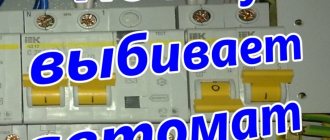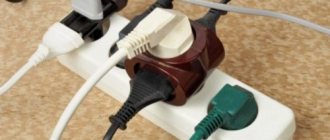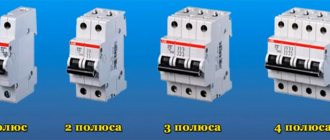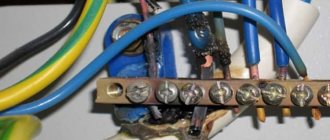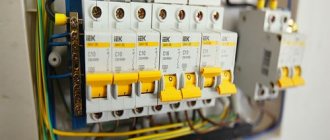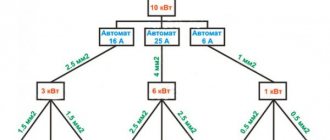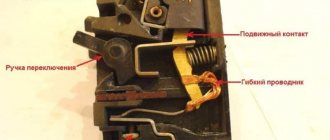A device designed to turn off the power supply to the network when disturbances occur in it that can lead to failure of the wiring and equipment connected to it, in electrical engineering it is called a circuit breaker (AB). This device is usually called more simply - an automatic machine. One of its varieties is a residual current device, which de-energizes the line when a current leak is detected, thereby preventing people from being electrocuted when touching the cable. The peculiarity of the RCD is that it cannot be installed without an AV that protects the line from short circuits and overvoltage. In order not to connect two protective devices to the line, a differential circuit breaker was created - a device that combines the functions of an RCD and a circuit breaker.
Features and purpose of the difavtomat
If almost everyone knows about ordinary electric automatic machines, then when they hear the word “difa-automatic”, many will ask: “What is this?” In simple terms, a differential circuit breaker is a circuit protection device that cuts off the power in the event of any fault that could result in damage to the line or electric shock to people.
The device consists of several main parts:
- Plastic body, resistant to melting and fire.
- One or two power supply and power off levers.
- Labeled terminals to which incoming and outgoing cables are connected.
- “Test” button, designed to check the serviceability of the device.
In the latest models of these machines, a signal indicator is also installed, which allows you to differentiate the reasons for the operation. Thanks to it, you can determine why the device turned off - due to a current leak or due to a line overload. This feature makes troubleshooting easier.
Visually about the device of the difavtomat in the video:
Automatic residual current protective switches can be installed in both single-phase and three-phase lines. They are intended for:
- Protection of the electrical network from short-circuit overcurrents and excessive voltage.
- Prevent electrical leakage that could cause fire or electrocution to people and pets.
The residual current switch for household lines with one phase and operating voltage 220V has two poles. In industrial networks at 380V, a three-phase, four-pole differential circuit breaker is installed. Quadrupoles take up more space in the distribution panel, since a differential protection unit is installed with them.
Installation of a three-phase automatic circuit breaker
In order to smooth out the consequences of erroneous actions on the part of users of electrical networks, and to make the process of using electricity safer and more comfortable, protection devices are used. One type of such device is a three-phase differential circuit breaker.
Purpose and application
The difavtomat must be used in conditions where involuntary mechanical damage to the insulation of conductors or breakdown due to high humidity is possible, that is, when there is a risk of electric shock to humans or animals.
In practice, these can be places where a large number of people stay (concert halls, shopping malls), premises for breeding and keeping animals, swimming pools, baths, Jacuzzi baths, production workshops.
Electrical installation rules recommend the use of differential circuit breakers in other cases where increased safety requirements are required.
note
It is obvious that at electrical facilities powered by a three-phase alternating current network, it is necessary to use a three-phase automatic circuit breaker.
A difavtomat is a device that combines two others in its design - a circuit breaker and a differential relay or residual current device (RCD).
These two devices are completely different both in design and operating principle. Replacing one with the other is unacceptable. Sometimes the cost of a three-phase automatic circuit breaker is more expensive than the RCD and circuit breaker combined. In this case, the owner decides that it is better to install it on a three-phase network.
Installation required
To understand how important the use of one and the second device is, we need to consider this situation. Let's say a small electric heater with a power of up to 1 kW is installed in the room. There may be no ground pin on the power cord.
In the event of a breakdown and short circuit of the phase wire to the heater body, a potential difference occurs between the body and the ground. The circuit breaker will remain on, since the current in the circuit has not increased. Touching the heater may result in electric shock.
Installing an RCD will ensure shutdown before the current value increases to dangerous values.
In the event of a short circuit, the RCD will detect it as a load and continue to operate until the transformer windings burn out inside. In this case, an automatic machine will help. Disconnection will occur immediately after contact of the phase and neutral conductors.
If the insulation of a power cord lying on a damp wooden floor is damaged, a current may occur at the point of contact between the phase conductor and the floor. Under certain conditions, the wood may heat up and ignite. In this case, the RCD will trip earlier, while the circuit breaker may not react.
In the situations considered, the most appropriate would be to connect a difavtomat, since its installation in a switchboard is much more compact.
Appearance
Externally, the three-phase automatic circuit breaker is a housing made of heat-resistant plastic with eight screw terminals to which the supply wires are connected (on top of the housing) and the wires to which the load is connected (from the bottom). A diagram of the internal structure is applied to the case.
Structurally, a three-phase differential circuit breaker is a device that combines a three-phase differential relay and a three-phase circuit breaker in one housing. It is usually mounted on a standard 35 mm DIN rail and can occupy 6-7 modules.
Principle of operation
Inside the three-phase automatic machine there is a transformer, the coils of which are wound on a toroidal core. When winding the coils, four pieces of wire are used - 3 phases and zero.
When a load is connected, magnetic fluxes arise from the phase and neutral wires in the transformer. In the absence of leakage, the total current in the phase conductors is equal to the current in the neutral conductor, but opposite in value.
Ia+Ib+Ic-In=0
As a result, the total magnetic flux of the transformer is zero. If a leakage current occurs in the circuit in at least one of the wires, a magnetic flux appears and, acting on the winding of the electromagnetic relay, causes it to operate. As a result, the three-phase automatic circuit breaker is switched off.
Important
The thermal release contains a bimetallic plate in its design, which heats up when a current of a given value occurs and, changing the geometry, affects the mechanism.
The electromagnetic release consists of a solenoid coil, the core of which is drawn into the housing when the current value in any of the phase wires increases, and at a certain moment the mechanism is triggered.
Installation
The rules for installing a difavtomat in a three-phase network are the same as in a single-phase network, only the number of phase wires is increased.
A three-phase difavtomat is installed immediately before the load consuming three-phase current, or at the entrance to an electrical installation in which the load is distributed across phases after the difavtomat.
The main condition for the correct operation of a three-phase automatic circuit breaker is the inadmissibility of installing it in circuits in which the neutral conductor is connected to the grounding conductor.
Before installation, the device body must be inspected to ensure there are no cracks or other obvious defects. Installation is carried out after first turning off the mains voltage.
The difavtomat is fixed on the rail, the insulation of the connecting wires is stripped and they are connected to the connectors according to the diagram. The input wires must come from the top.
After this, apply voltage and check how the electrical network works. This completes the installation.
Source: https://EvoSnab.ru/oborudovanie/avtomatika/trehfaznyj-difavtomat
Appearance of the difavtomat
When looking at the RCD and differential AV, you will notice that they are very similar in design and size. There is even a “Test” button on both devices. But this does not mean that they are completely the same. The residual current device is not an independent device and, as mentioned above, should not be installed in a circuit without a protective circuit breaker. The difavtomat combines an RCD and an AV, so it does not require the installation of additional devices.
In order not to confuse the RCD and the differential protective switch, most domestic manufacturers mark their products with the corresponding abbreviation - RCD or RCBO. Imported devices can be distinguished by other characteristics. For example, the current rating of a residual current device is indicated by a number and the letter “A” (Ampere) after it - for example, 16A. The current rating of the difavtomat is written differently: a Latin letter is placed in front, corresponding to the characteristics of the built-in releases. After it comes a number indicating the value of the rated current - for example, C16.
Overload and short circuit protection
Now let's talk about how a differential circuit breaker works when a short circuit occurs in the circuit and when the voltage increases significantly. In these cases, its operating principle is similar to that of a conventional circuit breaker.
The RCBO contains two releases that operate independently of each other. Each of them is designed to de-energize the network when various disturbances occur.
The video shows the internal structure of the difavtomat:
Protection against line overloads is provided by a thermal release, the role of which is performed by a plate of two metals with different expansion coefficients (bimetallic).
When the voltage in the circuit exceeds the nominal value, the plate begins to heat up, which leads to its bending towards the disconnecting element. By touching it, she triggers the AB.
The network is protected from short circuit overcurrents by an electromagnetic release, which is a solenoid with a core. With a sharp increase in current strength, characteristic of a short circuit, an electromagnetic pulse occurs. Under its influence, within a fraction of a second, the release causes the switch to operate and stop the supply of electricity to the line.
When the fault has been resolved, the device can be turned on manually again. However, it should be remembered that if the network parameters returned to normal very quickly after turning off the AV, the device should be given a little time to cool completely. If you turn on a heated device, this will negatively affect its service life.
Automatic Differential - AD
These machines are combined protective devices, the housing of which simultaneously combines machines - RCDs and circuit breakers that disconnect the zero phase in the event of any emergency situations on the power line.
Functions of difavtomats
When connecting RCDs and circuit breakers, these devices perform 3 functions:
1. Monitor and disconnect power lines when a short circuit occurs. 2. Disconnect the electrical network from consumers when large overloads occur in it when the voltage increases above the maximum value. 3. Turn off the power line in case of electric current leakage, which may occur if the insulation is damaged.
Advantages and disadvantages of automatic machines
The main advantage of differential automatic machines is reliable protection of electrical wiring and complete safety of its use.
The difavtomat has a compact design; in addition, its circuit is designed in such a way that one can replace, for example, three circuit breakers and the same number of RCDs installed on each individual power line. As a result, instead of six protective devices, one automatic device is installed.
In addition, this device has a window through which you can detect a power outage.
RCBOs in complex electrical wiring systems, when it is necessary to install a fairly large number of automatic protective switches, which reduces the size of the electrical distribution board in a house or apartment several times.
The disadvantage of difavtomats is that if any one part of the device fails, it is completely replaced. Some models are not equipped with monitoring windows, which can complicate troubleshooting.
Principle of operation
To control the voltage in the electrical network, an electromagnetic coil is built into the differential machine, which switches off when a voltage exceeds the maximum current is generated in the circuit, or vice versa, if it drops below the minimum value.
Inside the coil there is a core around which a directed electromagnetic flux is formed. Depending on its direction, the voltage on the secondary winding may be zero, while the machine operates in normal mode. If voltage is generated in it, which indicates a current leak, the electrical circuit is automatically switched off.
Installation procedure
The RCBO is mounted on a DIN rail. When connecting, you need to be very careful not to confuse the order of connecting the cables. In household single-phase lines, the input conductor is connected to terminal number 1, and the output conductor is inserted into terminal number 2. The neutral wire is connected to the terminal marked with the letter N. Input cables are connected to the top of the device, and output cables to the bottom.
You can connect the outputs to the line directly. If the network parameters are not stable, or you want to ensure the highest level of protection, you should install additional AVs.
The neutral wires from the machines must be connected to an isolated neutral bus. To avoid failure of the device or its incorrect operation, it is necessary to ensure that the output neutral cable does not come into contact with other conductors or with the body of the electrical panel.
You can see how to connect the difavtomat in the video:
What to choose?
Experts know about the operating principle of automatic devices and RCDs. Here you cannot simply compare, talking about some device in the categories of bigger, better and stronger.
They have almost the same characteristics, if the latter also has an automatic pre-installed. This is similar to comparing a car's sets of tires for winter and summer, choosing from them the only correct option. They are needed for the same purpose, but the conditions of use are noticeably different.
First, look at the place where the equipment will be installed. There may be some minor features. For example, the shield is small, there are shortcomings in connection, and no one can cancel the financial aspect. Some criteria can be neglected, while others can be focused on.
Read here! Electric motor stator - structural design, principle of operation, performance testing and repair features
If basic protection of one end customer or a simple line is needed, then a difavtomat is best suited.
Grounding of RCBOs
The neutral cable should be grounded only in front of the differential protection device. An incorrect connection will lead to the fact that the difavtomat will turn off even when a small load is applied.
If several differential circuit breakers are connected in parallel, then it is impossible to swap the neutral conductors at their outputs or connect them to a common zero bus. This will also cause the devices to malfunction.
The neutral point of the RCBO should be connected in pairs with its own phase. It cannot be used as a neutral conductor for devices with a different phase source.
To avoid mixing up the zeros, it is recommended to use marked cables.
For jumpers and connections, it is necessary to use a conductor whose cross-section corresponds to the network load.
If the machine is equipped with a malfunction indicator, the reason for the operation will be immediately clear. In the absence of a “beacon”, the cause of the failure will have to be found using the “scientific poke” method. If the RCBO starts to trip after connecting an additional load to the network, then most likely the device is faulty or an error was made when connecting it.
